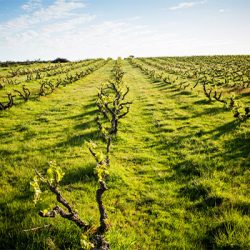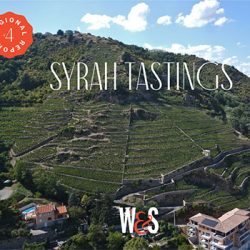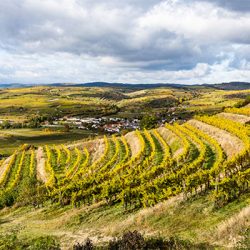Central Coast
2019
In pinot country in California’s Central Coast, Santa Barbara, San Luis Obispo, and Monterey Counties, temperatures through the growing season of 2019 were closer to historic averages, before the effects of climate change and drought distorted those numbers. It was a wet spring, with a late budbreak and cooler than average temperatures. The water in the soil led to fairly high vigor, and mildew pressure was commonly reported. Fruit set and veraison were also later than in recent years; with no appreciable heat spikes, the fruit development was relatively slow and unimpeded. Harvest was up to three weeks later than in the previous two vintages, with excellent fruit quality and relatively high yields. —P.J.C.
North Coast
2020
A vintage challenged by devastating fires in late summer, the season until then was favorable to growers. Vines untouched by smoke taint had the potential to produce exceptional wine. The season in the Russian River Valley started with a dry winter and early spring rains. Cool temperatures brought spring frosts, and summer’s warmer temperatures culminated in extreme heat in August. On the Sonoma Coast, a wet January and a drier end to winter led to an early budbreak. Then rain in May tamped down pollination and held down yields. The summer was cool on the coast, where temperatures were below 2018 and ’19. Warm weather at the start of August accelerated ripening, then the weather moderated before the fires.
Predictions of extreme heat mid-month led some growers to move quickly to harvest. What would become the Walbridge fire in western Sonoma County was sparked by a lightning storm on August 17; the Glass fire, whose origin remains undetermined, impacted inland Sonoma, starting on September 27. Overall, 2020 proved to be the most destructive wildfire season in California history, by a wide margin. Still, not all vineyards were impacted and of those that were, many growers chose not to release their wines. —J.G.
2019
North Coast pinot noir districts saw more variations in weather than in most recent vintages, and, while the roads from budbreak to harvest may have been different, the outcomes were generally favorable. On Sonoma’s far coast, David Hirsch recalls the winter leading into the 2019 season, writing on his website: “Record-breaking rains in February flooded the Russian River Valley and dropped 18” at Hirsch in just three days. These wet, cold conditions persisted for much of the winter, allowing the vines to properly hibernate and rest.” Budbreak began at the far coast site on April 4. There and in the Russian River Valley, rain in late May delayed flowering, causing some shatter. In June, on the coast, sunny skies shortened the flowering period of the vines and led to a healthy fruit set.
On his website, Ted Lemon at Littorai remarked on the difference between the “lush growth and deep green canopies” of the Russian River Valley and the short shoots of the vines on the coast. He also commented that the vines in Anderson Valley were in full bloom by the end of the first week in June, the shoot growth stronger and leaf color better than on the Sonoma coast. Then, things changed. “The first couple of weeks of July were virtually fog-free in Sebastopol with brilliant mornings and some warm afternoons,” he wrote. “Anderson Valley saw the opposite with many foggy mornings.”
The summer evened out on Sonoma’s far coast, with mild, sunny conditions and few days above 90 degrees. August was also sunny in the Russian River Valley, with warm nights and little fog.
Pinot noir growers throughout the north coast reported a leisurely harvest, spread over several weeks rather than rushed. The top wines offer freshness and exceptional aging potential: lithe and focused in Anderson Valley; firmly structured on the far coast of Sonoma; supple and satisfying in the Russian River Valley. —J.G.
2018
A warm, dry winter led into the 2018 growing season. A storm blasted the coast in early January, but rain did not impact the Russian River Valley until mid-February, then continued, on and off, through March. The vines budded out into a cool spring on the coast, while inland, the temperatures were warmer; in both cases, flowering was slow to start until conditions improved at the end of May, and early June proved favorable for bloom.
The summer on the coast was mostly cool, with a heat wave at the end of July, then moderate temperatures in August, with warm nights. The end of the month brought intense fog, relieved, eventually, by winds that reduced disease pressure on the vines. Warm temperatures returned in the second week in September, bringing the grapes to ripeness. Williams Selyem started to harvest in the Russian River Valley on the 16th of August. Hirsch started on September 11 in Fort Ross. Harvest conditions remained favorable until the end of the month, then rain arrived in early October. Growers in Sonoma were generally relieved to get through the season without a significant fire event, though Lake and Mendocino counties were not as fortunate: Fires broke out north of Hopland and northeast of Ukiah on July 27 and were not fully contained until September 18. Some vineyards in Anderson Valley were impacted, but there are dynamic wines from the sites that were not, with cool depths of flavor. The best of the Russian River Valley wines combine richness with freshness in their earthy tannic detail, those ageworthy tannic structures playing out with more red fruit transparency on the far coast. —J.G.
This vintage report is published as part of our Regional Tasting Report on US Pinot Noir.
This is a W&S web exclusive. Get access to all of our feature stories by signing up today.





















